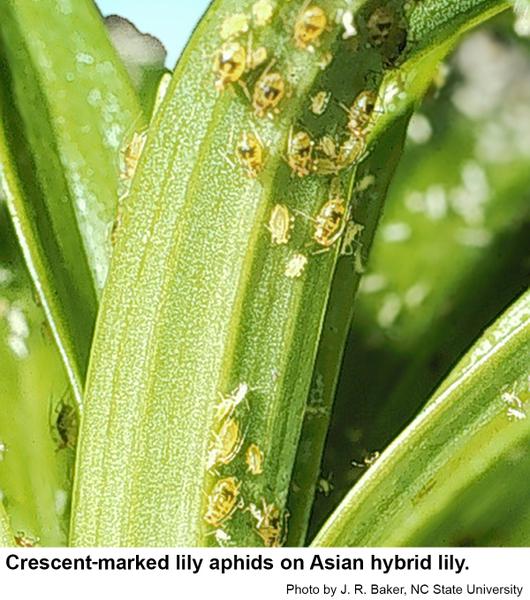Description and Biology
The crescent-marked lily aphid, Neomyzus circumflexus (= Aulacorthum circumflexum), is a large, handsome aphid up to 1/8 inch long. It is sometimes called the lily aphid or the mottled arum aphid. Wingless forms are shiny, whitish, yellowish, or green and have three dark lines across the thorax (the second and last lines are broken in the middle) and a dark, noticeable horseshoe marking (heels facing forward) on the abdomen. The antennae are up to one and a half times the body length. The cornicles are long and dusky with a darker flange. The cornicles are up to twice the length of the cauda. The crescent-marked lily aphid has no male stage in the life cycle and no egg stage. Each female gives birth to tiny versions of themselves. These nymphs soon grow and molt several times before molting into a winged or wingless adults. This aphid is not attended by ants.
Host Plants
In temperate climates the crescent-marked lily aphid is primarily a pest of greenhouse crops where it attacks adianthum, arum, asparagus, begonia, calla, cineraria, cyclamen, ferns, fuchsia, lily, pansies, viola, zantedeschia, and many others. These aphids also occur outdoors in warm weather either by piggybacking into the landscape on bulbs or potted plants or perhaps by flying from a greenhouse or infested plants nearby. Heavy infestations cause direct harm to many ornamental plants, and these aphids also transmit viruses.
Residential Recomendations
In warm weather, parasitic wasps, lady beetles, syrphid fly maggots, lace wings and other predaceous insects may feed on aphids so that aphid populations may decrease rapidly. Aphid populations are sometimes devastated by Cephalosporium lecanii, a fungus that infects aphids as a sort of super athlete's foot disease. Because ornamental plants are somewhat sensitive to pesticides, water plants thoroughly before spraying them and try to treat them early in the morning or late in the evening so that the pesticide residue is dry before the plants are exposed to direct sunlight. An insecticidal soap or horticultural oil should give adequate control of aphids although a number of other pesticides are labeled and should give adequate control. Insecticidal soaps and horticultural oils have less impact on beneficial insects that do the pyrethroids now widely labeled for home landscape use.
References
- Aphids on Ornamental Landscape Plants. Frank, S. 2009. Entomology Insect Notes, NC State Extension Publications.
- Genus Aulacorthum, Aulacorthum aphids. Dransfield, B. and B. Brightwell. 2016. InfluentialPoints.com.
- Lucid Identification guide for cosmopolitan and polyphagous aphid species. Anonymous. 2014. Aphidnet.org.
- Neomyzus circumflexus (Buckton). Mau, R. F. L., and J. L. M. Kessing. 2007 (Update). Crop Knowledge Master, Extension Entomology & UH-CTAHR IPM Program, University of Hawaii, Manoa.
- Extension Plant Pathology Publications and Factsheets
- Horticultural Science Publications
- North Carolina Agricultural Chemicals Manual
For assistance with a specific problem, contact your local Cooperative Extension Center.
This Factsheet has not been peer reviewed.
Publication date: May 18, 2016
Reviewed/Revised: Sept. 13, 2019
Recommendations for the use of agricultural chemicals are included in this publication as a convenience to the reader. The use of brand names and any mention or listing of commercial products or services in this publication does not imply endorsement by NC State University or N.C. A&T State University nor discrimination against similar products or services not mentioned. Individuals who use agricultural chemicals are responsible for ensuring that the intended use complies with current regulations and conforms to the product label. Be sure to obtain current information about usage regulations and examine a current product label before applying any chemical. For assistance, contact your local N.C. Cooperative Extension county center.
N.C. Cooperative Extension prohibits discrimination and harassment regardless of age, color, disability, family and marital status, gender identity, national origin, political beliefs, race, religion, sex (including pregnancy), sexual orientation and veteran status.

